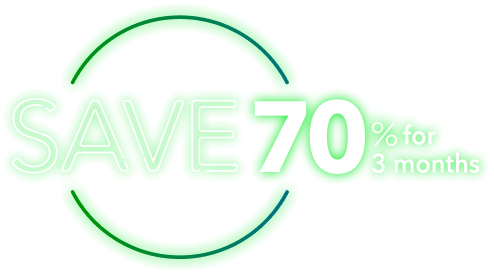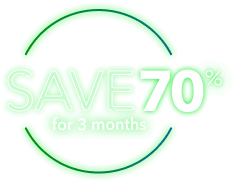Building your small business website: 5 steps to follow
As with anything, getting started is the hardest part. If you’ve explored creating your own website before, you probably took one glance at all the jargon (uhh...hosting, responsive design, and search engine optimization?), closed your browser tab, and vowed to live off the grid forever.
Not so fast. If you’ve got a keyboard and a mouse, you can do this. Here are a few easy steps you can take to create your own small business website—without all the stress and confusion.
1. Purchase and register your domain name
First things first: You need a domain name. This is just a fancy way of saying the URL or website address (starting with “www”) that people will use to get to your website.
When it comes to choosing your domain name, you want it to be something simple and relevant to your business. Ideally, it’ll be intuitive enough for your customers to remember easily.
Let’s say you’re opening your own bagel shop called The Corner Bagel Shop. You’d want your domain to be something simple and to the point, like www.cornerbagelshop.com.
That’s a great URL! Nice choice. But you actually have to buy it before you can claim it.
Where do you purchase a domain name? Today, almost everything you need to build your business website—your domain name, hosting (which we’ll talk about next), templates, and more—is included in one platform or website builder. Something like Squarespace or Wix will get you everything you need in a one-stop shop.
But if you’re looking to just purchase a domain to get started, there are plenty of places you can do that. These include:
Using one of those platforms, search for the domain name that you want to use. If it’s available, you’ll purchase it and fill in your information—and you’re the proud new owner of that domain.
What if your domain name is already taken?
It’s not uncommon that the domain name you want to use is already taken and unavailable for purchase. What then? There are a few things you can do, including:
- Change the ending: It’s true that .com endings are the most common (and they’re probably your best bet if you can swing it). But there are other options you can use, like .net, .info, or .za
- Add another word: Even adding one small word can make your domain different enough to be available. So, if www.cornerbagelshop.com is taken, you might be able to secure www.thecornerbagelshop.com.
- Add your location: No dice? Try incorporating your location in some way. For example, www.sacornerbagelshop.com might be available.
How much does a domain name cost?
Domain names can be surprisingly cheap. For example, Google Domains says that purchasing www.cornerbagelshop.com will cost just R12 per year. Exactly how much you’ll need to spend will vary, but planning for R10 to R20 per year for your domain is probably a safe bet.
2. Secure your website hosting
The idea of website hosting can feel a little technical and complex, but think of it like this: It’s where your website gets stored. The information on your website needs to live somewhere, and that’s the job of hosting. It stores that information and then makes it accessible to visitors.
There are two types of hosting for websites:
- Hosted: Your website is built on a ready-made website builder like Wix or Squarespace.
- Self-hosted: You purchase hosting separately and then build your own website from scratch.
While a self-hosted website gives you far more flexibility and customization options, a hosted website is best when you’re just getting started. You’ll have a far easier time using a drag-and-drop website builder as opposed to trying to start from scratch with a self-hosted website. That can come later when you have the resources to work with a professional.
With that in mind, you’ll likely end up purchasing your domain and hosting all in one spot: from the website builder you choose (which we’ll talk about in the next section). If you decide to purchase hosting separately, most of the domain providers we listed above also offer hosting for the domain you choose.
3. Find your website builder
There are several website builders available that will offer the following wrapped up in one solution:
- Domain name
- Hosting
- Easy interface to design and build your website
A website builder is a great choice for business owners who need to create a simple website but don’t necessarily have a lot of experience.
As you explore the different website builders available, keep in mind the features you need. For example, will your bagel shop need e-commerce functionality so people can order bagels and seasoning online? That’s an important consideration as you evaluate your options.
Once you know what you’re looking for, it’s time to look at the different builders. Some of the most popular ones include:
- GoDaddy
- Best for: Businesses that need to get a simple website set up fast.
- Price: Plans start at approximately R160,00 per month (when billed annually).
- Shopify
- Best for: Businesses that plan to focus primarily on e-commerce.
- Price: Plans start at approximately R460,00 per month.
- Squarespace
- Best for: Businesses that want a huge selection of website templates.
- Price: Plans start at approximately R190 per month.
- Weebly
- Best for: Brick-and-mortar businesses that also want smaller e-commerce functionality.
- Price: Plans start at approximately R95,00 per month.
- Wix
- Best for: Businesses that want an easy-to-use interface.
- Price: Plans start at approximately R220,00 per month.
Using these platforms, you can get your domain, hosting, and templates that make it easy to design a beautiful, impressive website for your small business.
As you explore your options, you’ll likely also run across WordPress. It’s one of the most popular website builders around, with an estimated 30% of websites running on the platform.
However, it’s important to note that WordPress has two different options for websites—and they can cause a bit of confusion. Here’s the gist:
- WordPress.com: This is the company’s hosted website builder, meaning you’ll build your website on WordPress’s platform. You’ll need to purchase a domain elsewhere and register it with WordPress.
- WordPress.org: This is by far the more popular WordPress option. Websites built using WordPress.org are self-hosted. They’re completely customizable because there’s no drag-and-drop builder—meaning you’ll likely need to work with a web designer to build your website.
There’s no shortage of options, and there’s not one right choice for every type of business or business owner. Nonetheless, going with Wix or Squarespace is a safe bet to create a functional website without a lot of stress.
4. Collect your website content
Take a deep breath, because now a lot of the head-spinning technical work is behind us. You have your domain, your hosting, and you’ve selected your website builder. Now it’s time to start to pull together the information that actually needs to go on your website.
To start, take a look at the templates your website builder offers and land on one you like. That’ll give you some direction about the type of content you’ll need to fill it up—how many photos, what blocks of copy, and more.
It’s possible that your template will come with far more pages than you need (don’t worry, they’re easily deleted). At a bare minimum, your business website should include:
- Homepage: The “need to know” of your business.
- About page: Details about the history of your business and even yourself as the business owner.
- Products and services page: Information about what your business offers. If you have an ecommerce website, customers should also be able to add items to their cart here.
- Contact page: How people can get in touch with you. If you have a brick-and-mortar location, you should also list your business address.
You might also want to add a blog, an FAQ page, testimonials, or other pages. But, for now, don’t get too hung up on the extras, and stay focused on the bare bones you need to get started.
Now it’s time to start pulling together images, product descriptions, and other written content you’ll include on your website.
Start with one folder or document where you can keep all this information in one spot. It’ll make things a lot easier when it’s time to actually start dropping it into your website template.
5. Publish your site
You’ve pulled together all of the content you need. Now, all that’s left to do is add it to your website builder.
The great thing about website builders is that they’re super easy to customize. Their user-friendly interface makes it simple to:
- Add or delete pages
- Change fonts and colors
- Add your logo and other branding elements
- Reorder sections and pages
The best thing you can do is get into your website builder and just start playing around. You’ll learn a lot about how it works. Plus, you can take comfort in the fact that it’s easy to undo any changes if you make a mistake.
Once you have your basic website looking the way you want, publish it. Don’t obsess over it being absolutely perfect—you can always add to it and change it later.






